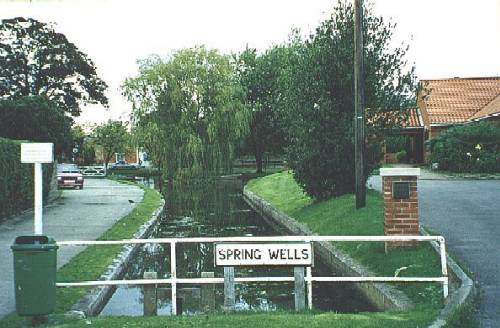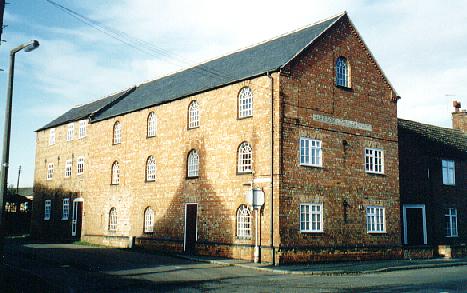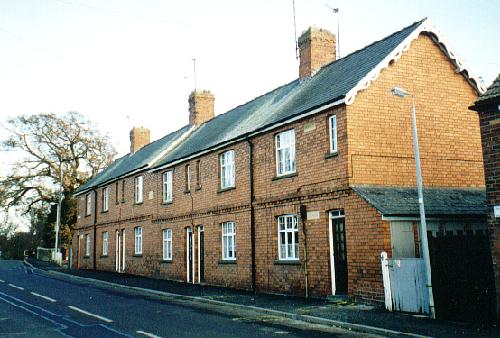|
Billingborough
There are a dozen places in England that remember the name of Billings, a famous tribe of northern invaders, and one of them is Billingborough, lying on the edge of the fens nine miles north of Bourne with the Roman built Car Dyke close by. It was here that the Saxon tribe of the Billings pitched their camp on the first rise of the lush green land after the reedy wastes of the fens. The village was also the site of an Iron Age settlement and evidence of Roman occupation has also been found in the locality together with at least nine salterns, making the parish an important place in one of Lincolnshire's early industries, salt making.
The natural artesian springs at Billingborough have been used to great effect to provide a water feature of peace and tranquillity in the very heart of the village. This spot is known as Spring Wells and probably attracted the first settlers here because the water was reputed to be chalybeate, or rich with iron salts, and to have healing qualities and other benefits for good health. Only once in recent years have the springs been known to fail. On 1st January 1967, after several dry seasons, they dried up and remained dry for six weeks before re-appearing. Summer and winter alike, the temperature of the springs is a degree or two above freezing.

The Spring Wells have been enhanced as a community facility in recent years although the water is likely to be quite insalubrious and it is therefore appropriate that the village's medical practice is located in new buildings in the immediate vicinity while this has become a place to sit and dream and watch the world go by and for swans and waterfowl to congregate for the duck house placed here by villagers sends a message to our feathered friends that they are always welcome visitors.
Today, Billingborough has the atmosphere of a small county town with a wide main street bounded by shops, garages, pubs and large houses. It could also have been a busy inland port laid out some 150 years ago but the scheme never materialised. It was announced on 3rd September 1813 that Parliament was being asked to approve a bill for making a navigable cut or canal from the Forty Foot Drain running between Bourne and Boston with locks, staunches and hauling paths, and a meeting was held at the Fortescue Arms later that year to consider the cost of the project and other implications but the enterprise foundered either through lack of money or interest.
|
Among the oldest buildings in the village is the Old Hall, a Tudor mansion with 18th and 19th century additions. It had been the home of the
Tollers, a distinguished Lincolnshire family that flourished in the 16th and 17th centuries and reputedly descended from another prominent county line, the
Custs. Henry Toller was born at Horbling and buried there in 1561.
His successor William started building this dignified stone house in 1611 and the work was finished by his son Richard in 1623. Stones from the suppressed Sempringham priory two miles away were used in its construction and many have been found during subsequent repair work bearing dates and mouldings while the main doorway on the west of the house was brought intact from Sempringham. |
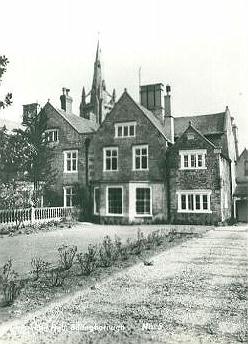 |
The name Toller has been associated with several village
charities known as the Toller Charity, run by trustees who administered the money
derived from property at Billingborough and Gosberton left by John Toller in
1669 and Mary Toller in 1671. The charity was originally formed to provide the
salary for a schoolmaster to teach poor children from the village but also
financed other good deeds including the distribution of coal for the poor at Christmas.
The charity was reconstituted in 1890 and from then on, the income was divided
between the village schools at Billingborough and Horbling, and Billingborough
Sunday School, to pay for prizes and teaching equipment that were not provided
by the local education authority.
Several subsequent members of the
Toller family later attained distinction, mainly in the church, but by 1802, the
name had become extinct. The hall and its grounds were surrounded by a substantial wall with two entrances for carriages and in the 19th century, it was divided into three residences. There were moves in 1914 to schedule the property for preservation but the war broke out and nothing was done and in recent years it has been extensively converted for use as a retirement home for elderly residents.
|
 |
|
Buckminster Manor pictured circa 1970 (above) and a
photograph from circa 1880 (below) showing Mrs de Burton setting out for a drive in her carriage.
The two photographs at the bottom were taken in 1983 when the house was
used as a county council children's home. |
|
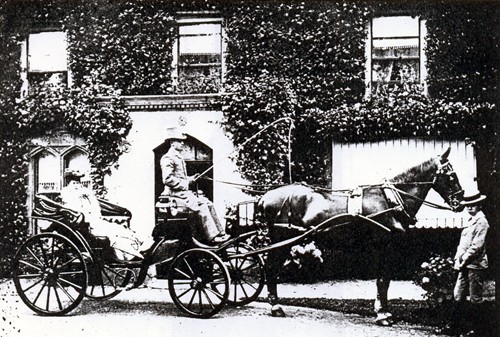 |
|
 |
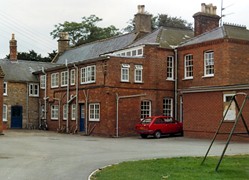 |
Buckminster Manor took its name from the family of Buckminster whose members
held it until the reign of Edward IV when Robert Burton married Elizabeth
Buckminster whereby the Burton family took possession until the time of Henry
VII when it was forfeited to the crown. The manor was eventually sold to Martin
Burton about 1541 and handed down in that family until the early years of the
20th century when it was occupied by Lieutenant Colonel Albert de Burton who
died childless in 1913.
The date of the original mansion is doubtful but an inscription on the central
chimney stack shows that Thomas Burton who married his cousin Ann carried out
structural alterations in 1669. The initials T-A and date are followed by an
inscription in Latin which roughly translated means "My haven now - soon to be
his - later I know not whose". One of the exterior features of the mansion is a
decorative French window whose delicately moulded terracotta mullions are much
admired although the beautiful row of horse chestnut trees leading to the house
are long since gone. In 1951, the house was acquired by Kesteven County Council
for use as a children's home and registered as Buckminster House but has since
been sold and is now a private residential care home for the elderly.
|

|
|
St Andrew's Church has a slender
recessed spire soaring 150 feet while the tower rises at the west end of the north aisle and has a fine vaulted roof and pinnacles linked by delicate flying
buttresses to the spire which has three tiers of lucarnes in
alternating positions. The tower and the church are mainly 14th century but there are traces of earlier work in the south aisle. The chancel was rebuilt in 1891 and the most impressive part of the building is the nave with four great arches on each side and the light streaming through the twelve windows of the 15th century clerestory. |
|
REMEMBERING THE DEAD
There is a monument here to Mary Wayet from 1831 and is the work of
Crake of Chelsea, the inscription in black letter capitals. The churchyard
also contains a number of interesting tombstones including one recording the death of a husband and wife and their two eldest children, all within two years of each other, while an addition to the inscription remembering nine other children who died in their infancy reminds us of the hardships of childbirth before the more enlightened days of natal care.
In memory of Thomas Haddon who died May 3rd, 1826, aged 66.
Also Elizabeth, his wife, who died June 6th, 1825, aged 59 years.
Also of Joseph, son of the above, died May 29th, 1824, aged 24.
And of Ann Haddon, their daughter, died September 28th, 1824, aged 18.
And also nine children who died in their infancy. |
 |
A
Wesleyan society of twenty members was active in Billingborough in 1802 but it
was not until 1829 that a chapel was built in at a cost of £300 plus an
additional £40 for the land. There were 30 recorded members by 1838 and
the 1851 ecclesiastical census recorded that there were 44 adults at the
afternoon service and 190 in the evening. The premises were enlarged in
1858 by the addition of a further gallery at a cost of £160. There was
also a large and active Sunday School with 146 children on the roll in
1846. A new chapel was planned and in 1899, the Fortescue Paddock in Vine
Street was purchased as a site from Trolley Thomas Houghton for £150.
The new building, designed to accommodate 450 people, was opened in
December 1903 at a cost of £1,304, some of which had been raised from
fifty children who had collected two shillings each for the privilege of
laying a brick. The old chapel had become dilapidated through disuse and
was subsequently sold in 1928 for £85. The Methodist cause in
Billingborough began to weaken during the late 20th century and the chapel
became such a drain on resources that in 1995, it was decided to demolish
the building and meet in the Anglican church, a situation that continues
to this day.
There
was also a Baptist Chapel in the village, built in the High Street in
1868, but it was bought by the Toller Charity Trustees in 1890 and
subsequently used as a Sunday School and for other parochial activities,
also as a canteen for the village junior school and as a welfare clinic.
It became known as Toller Hall but by 1967 the building was in such a poor
state of repair, with the walls bulging and dry rot in the roof timbers,
that architects decided it was in imminent danger of collapse and so it
was closed as a safety precaution and demolished the following year.

Across the churchyard is a row of mediaeval cottages with a red tiled
roof (above), altered over the years as family homes but containing enough originality to retain its period charm.
Red brick buildings abound in Billingborough and among the most striking is an old grain
warehouse (below left), now agreeably converted into flats, but the developers have retained the name of the original 19th century owner engraved on stone tablets built into the gable end that overlooks the main street:
HARRISON CORN
MERCHANT
A row of six terraced cottages known variously as Victoria Bank or Victoria Street
(below right) bears witness to local philanthropy in the early part of this century and a tablet records: "Erected 1914 in memory of faithful parents" while the upstairs rooms have been labelled
HIGH NESTS and the ground floors
LOW NESTS.
There were once seven public houses here but the Vine, the Five Bells, the Dove, the Grapes and the New Inn have gone and only the Fortescue Arms and the George and Dragon survive. The Fortescue Arms is an imposing whitewashed building in the High Street, named after the wealthy family that once owned 6,000 acres of land in this part of Lincolnshire. Earl Fortescue was formerly Lord of the Manor here but the Crown purchased the estates and the manorial rights in 1855 although the family still has farming interests in other parts of the county.

The original property is 300 years old but started life as a private residence and has been much added to over the years. Some of the stone used in its construction is reputed to have come from Sempringham Priory after its decline at the Dissolution and later when it was sacked by Cromwell's troops during the Civil War of 1642-51. There is certainly evidence that these materials were used for the building of several fine houses in the vicinity, notably that of Lord Clinton, later Earl of Lincoln, who pulled everything down and built himself a mansion 200 feet long although he died before it was finished. The property became a coaching inn for at least 150 years and the remains of old arches through which the stagecoaches once entered can be seen where there are now doorways while the stables that housed the horses for their overnight rest still stand at the rear of the premises.
| The odd little building at the corner of Vine Street and Victoria Street in Billingborough was formerly the village fire station. A plaque over the main door announces that it was built in AD 1890 and for the next half a century it housed a Merryweather hand pump appliance that was pulled by two horses with four firemen running either side who operated the water pump whenever there was a blaze in the
vicinity. The appliance was replaced by a modern fire engine when
the Auxiliary Fire Service was formed at the outbreak on the
Second World War in 1939 but was still used whenever necessary
although it was then pulled by a tractor. |
 |
After
the war it was taken out of service and retired to the Lincolnshire Fire Brigade
Museum. The wooden structure attached to the left of the building is the village
bus stop.
|
HERBERT STENNETT
(1881-1968) |
|
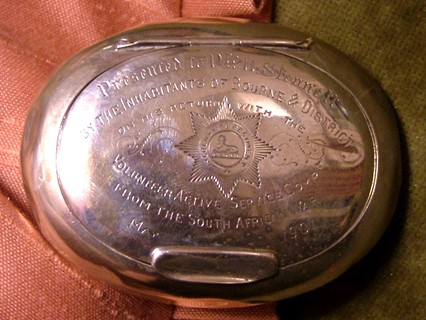 |
 |
|
One of the first to join the regular army to
fight during the Boer War of 1899-1902 was farmer's boy Herbert Stennett from Billingborough, near Bourne. He
was already serving as a volunteer with H Company, the 2nd Battalion, the Lincolnshire
Regiment, which had its headquarters at the drill hall in North
Street, but requested to serve overseas and sailed for South Africa in 1900. He was present with his
battalion at the capture of Johannesburg and Pretoria and also at
the Battle of Nitral's Nek where the regiment sustained a severe
battering and was compelled to retreat. When the war ended, he
served for a spell with the British South African Police Force but
returned home in 1905 to take over the family farm. His service
during the Boer War was recognised by the people of Bourne with the
presentation of a silver tobacco box and a silver inscribed
trophy for loyal service to the regiment.
Herbert was born at Billingborough on 24th April 1881, the fourth
son of Mr and Mrs W Stennett of Chestnuts Farm where he eventually
took over the tenancy from his elder brother Arthur. On 24th June
1914 he married Mary Elizabeth Goodacre (born at Billingborough 16th
February 1884) at St Andrew's Church and 50 years later they
celebrated their golden wedding with a family reunion.
He was a lifelong Methodist, becoming a lay preacher after his
return from South Africa, and had occupied the pulpit at practically
every chapel within the Bourne and District Circuit as well as many
in those adjoining, particularly at Tattershall Bridge where he
conducted the annual harvest thanksgiving service without break for
45 years. He was a keen cyclist and even in his final years took a
daily ride through the surrounding villages to keep fit. Mrs
Stennett, daughter of the watch and clock maker, Edwin Goodacre,
was also an enthusiastic Methodist and a member of the local
Sisterhood.
Mr Stennett died in January 1968, aged 82, and his wife in November
1986. Both are buried in the churchyard at Sempringham. They had two
children, a son and a daughter. |
|
See also Letters home
from the Boer War |
|
ROBERT GORDON LATHAM (1812–1888) |
|
Latham was an eminent ethnologist and philologist who
was born at the vicarage at Billingborough on 24th March 1812 and later
studied philology in Scandinavia. He graduated from King's College,
Cambridge in 1832, becoming a Fellow of King's College, and after studying
medicine he was appointed lecturer and assistant physician at the
Middlesex Hospital. But he was attracted to philology and ethnology and
was subsequently appointed professor of English Language and Literature in
University College, London in 1839 and director of the ethnological
department of the Crystal Palace in 1852. He retired in 1863 and died at
Putney on 9th March 1888. |
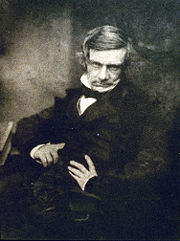 |
|
His many publications included Norway and the
Norwegians (1840), The English Language (1841), An Elementary English
Grammar (1843), Natural History of the Varieties of Man (1850), A Handbook
of the English Language (1851), Man and his Migrations (1851), Ethnology
of the British Colonies (1851), Ethnology of Europe (1852), The English
Language (1855), an edition of Johnson’s Dictionary, Nationalities of
Europe (1863) and Outlines of General Philology (1878.). |
|
FROM THE ARCHIVES |
|
William Jackson, of Billingborough, was summoned at
the Town Hall, Bourne, on Saturday last, on the complaint of John Huckbody,
for an assault. It appeared that complainant, who is a "Latter-day Saint",
was preaching in the open air at Billingborough on Sunday 21st ult. when
defendant at the instigation of others, went with a bell and interrupted
the proceedings. Case dismissed, complainant to pay costs 16s. 10d. -
news report from the Stamford Mercury, Friday 9th September 1853.
RACE: On Monday evening last, a race was arranged to come off on the
Pointon Road, the distance being half a mile from Pointon village to
Neslam Bridge. The competitors were D J Allen, a professional, and William
Taylor, a journeyman blacksmith. At the time fixed, each competitor toed
the scratch and Taylor cut out the work in good style and to all
appearance looked all over a winner. The pace, however, proved too rapid
and Allen, passing his opponent, won the race with ease. The stakes were
10s. each deposited. A large number of people witnessed the event.
- news report from the Grantham Journal, Saturday 6th August 1881. |
|
BILLINGBOROUGH IN PAST TIMES |
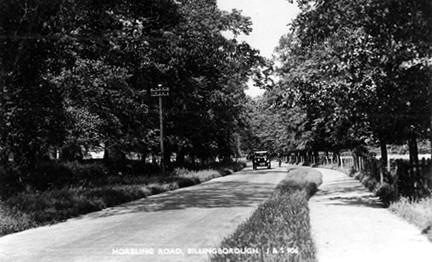 |
|
A picture postcard view of Horbling Road at
Billingborough
circa 1920. This is now the B1177. |
|
 |
|
The Spring Wells at Billingborough from a picture
postcard
published around 1930. |
 |
|
Billingborough Methodist Chapel from a picture
postcard
taken circa 1940. |
|
BILLINGBOROUGH'S SPRING WELLS
The beautiful spring of water, so long the pride and
ornament of this village, has of late been the innocent cause of a variety
of opinions as to its purity, and to allay all doubts in the matter, a
sample of the water has been sent to Dr Voelcker, of London, for analysis
who, we are happy to say, confirms the opinion which has made its goodness
a by-word for so many years throughout the whole neighbourhood. The
following is his report:
Analytical Laboratory, 11, Salisbury-square,
Fleet-street, London, February 28th, 1874. Dear Sir.- I have made a
careful analysis of the sample of water you sent me on the 14th inst. in a
stone jar, sealed with two small and one larger heraldic seals. The water
may be represented as follows:- An imperial gallon contains oxydisable
organic matter, 0-23; oxide of iron and alumina, and traces of phosphoric
acid, 0-14; carbonate of lime, 14-66; sulphate of lime, 6-69; carbonate of
magnesia, 1-30; nitrate of magnesia, 0-17; chloride of sodium, 1-65;
soluble silics, 0-42. Total solid constituents per imperial gallon, 25-26
grains. Free saline ammonia, 0-0004; organic alluminaid ammonia, 0-007.
The water was clear, colourless and free from all smell. Evaporated to
dryness it left a white residue, which scarcely changed in colour on being
submitted to a strong heat, in a platinum dish, showing that the water
contained but little organic matter. This is confirmed by the direct
determination of the amount of oxydisable organic matter, and the small
proportion of free organic ammonia. The amount of chloride of sodium
(common salt) also is small, and the water contains mere traces of
nitrates, which would not have been the case had it been contaminated with
sewage products. The principal constituents of the water are carbonate and
sulphate of lime. These render the water somewhat hard, and not well
adapted for cooking or washing purposes. It is, however, uncontaminated
with sewage products and other injurious organic impurities, and in my
judgment a perfectly wholesome and good drinking water. - Believe me,
yours faithfully, Augustus Voelcker.
- news report from the Grantham Journal, Saturday
7th March 1874.
|
See
also Clock and watch
makers Horbling
The Cooneyites

Go to:
Main Index Villages
Index
|
